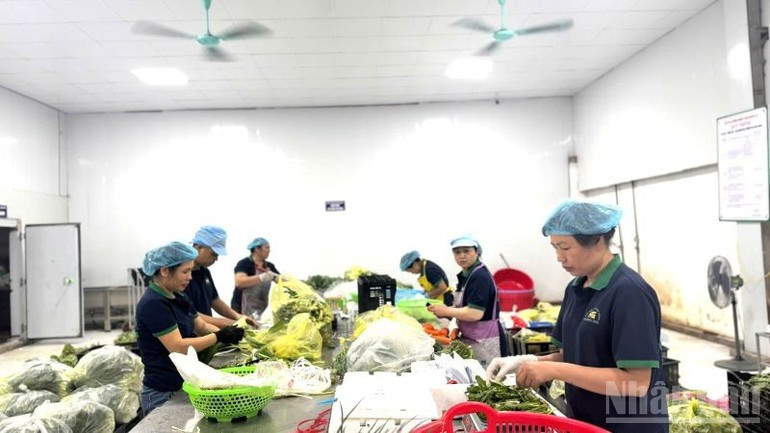Accordingly, in Resolution No.68/NQ-TW dated May 4, 2025 on private economic development, Viet Nam aims to have 2 million enterprises operating in the economy by 2030 and have at least 20 large enterprises participating in the global value chain.
In Directive No.10/CT-TTg dated March 25, 2025 on promoting the development of small and medium-sized enterprises, the Prime Minister also requested to prioritize resources and support so that by 2030 there will be 1 million more enterprises.
Solving difficulties for the private economy
According to statistics, the private economy, especially small and medium-sized enterprises (accounting for 98% of the total number of enterprises), plays an important role with more than 50% of GDP, 30% of total budget revenue and creates more than 40 million jobs. However, this sector still faces many difficulties in sustainable development.
According to the Directive, the Prime Minister requested ministries, branches and localities to synchronously deploy solutions to support small and medium-sized enterprises to make a breakthrough. In particular, it emphasized that ministries, branches and localities prioritize resources to support small and medium-sized enterprises, focus on innovative startups, improve competitiveness, participate in value chains, digital transformation, green transformation.
Notably, one of the key tasks is to perfect policies, reform administrative procedures, and create a favourable and equal business environment for small and medium-sized enterprises. Specifically, ministries, branches, and localities must remove barriers with the goal of reducing at least 30% of procedure processing time, 30% of compliance costs, abolishing 30% of unnecessary business conditions, and shifting from “pre-inspection” to “post-inspection” associated with increased supervision by 2025.

According to statistics, Viet Nam currently has about 1 million operating enterprises. Thus, from now until 2030, that is, about 5 years from now, Viet Nam needs to have 1 million more enterprises to complete the goals of the Party and the State.
Recently, the Socio-Economic Report for the third quarter and 9 months of 2025 of the General Statistics Office under the Ministry of Finance clearly stated that the number of newly established enterprises is on a strong upward trend. Statistics show that in the first 9 months of 2025, the whole country had 145,000 newly registered enterprises, an increase of 18.9% over the same period in 2024.
In addition, the whole country had 86,400 enterprises returning to operation, an increase of 41.3% over the same period in 2024, bringing the total number of newly established and returning enterprises in the first 9 months of 2025 to more than 231,300 enterprises, an increase of 26.4% over the same period in 2024. On average, 25,700 enterprises were newly established and returned to operation per month.
Also according to statistics, in the first 9 months of 2025, the number of enterprises temporarily suspending business for a period of time was 99,500 enterprises, an increase of 14.5% over the same period in 2024; 53,200 enterprises stopped operating pending dissolution procedures, down 13.5%; 22,300 enterprises completed dissolution procedures, up 45.0%. On average, 19,400 enterprises withdrew from the market per month.
Creating momentum for the implementation of the goal of continuing to have 1 million enterprises

Responding to a question from Nhan Dan Newspaper, Nguyen Thi Huong, Director of the General Statistics Office, emphasizsed: The number of enterprises entering the market is higher than the number of enterprises withdrawing from the market. This shows that the number of business registrations in the past 9 months has increased thanks to the “motivation” of Resolution No.68-NQ/TW to strongly develop the private economic sector.
In fact, in the structure of the Vietnamese economy, although the number of operating enterprises reached nearly 1 million, there were up to 5.2 million individual household businesses operating in early 2025.
In that context, Viet Nam has had many support policies to convert the household business model to the enterprise model, such as simplifying registration procedures, exempting and reducing some types of taxes and fees in the initial stage, providing legal advice and training on business administration, as well as supporting technology platforms, accounting and electronic invoices. Many localities have also deployed models of “household business conversion support teams” to provide direct guidance, helping people easily access information and complete procedures.

Adding to the answer to Nhan Dan Newspaper, Phi Thi Huong Nga, Head of the Department of Industry and Construction Statistics, General Statistics Office emphasised the Government and ministries and branches have had many solutions to promote and support household business for enterprises. Nga said that in order to achieve the set goals and further promote the transformation of household business, it is possible to consider 7 synchronous solutions, which are:
First, promote administrative procedure reform and improve the business environment. Although, in recent times, the Government and ministries and branches have made efforts to simplify many procedures, there is still a need for stronger reforms, especially in business registration, licensing of taxes, customs, and import and export. It is necessary to cut unnecessary business conditions, shorten the time for processing documents, and at the same time increase the transparency and responsibility of civil servants who work directly with businesses.
Second, expand financial support and access to capital for businesses, especially small and medium-sized enterprises and start-ups. It is necessary to implement preferential credit packages, loan guarantee mechanisms, and interest rate support to help businesses have more resources to expand production and business.
Third, improve the quality of human resources and promote technology transfer. The State needs to have policies to encourage businesses to invest in scientific research, innovation, strengthen links between universities and businesses in vocational training, improve skills, especially digital skills for workers.
Fourth, promote digital transformation and improve business management capacity, especially for newly transformed businesses. In addition to providing free or preferential software and management platforms, it is necessary to implement training programs on risk management, finance, operations and modern business management.
Fifth, support startups and innovation through improving legal policies, taxes, production premises, and at the same time creating conditions for access to seed capital for startups with growth potential.
Sixth, expand markets and promote trade. It is necessary to step up support for small and medium-sized enterprises to participate in fairs, connect supply and demand, expand exports and develop online sales channels and e-commerce, helping them participate more deeply in the production and distribution value chain.
Seventh, improve stable mechanisms and policies and accompany businesses. Tax policies need to be stable, transparent and highly predictable. At the same time, it is necessary to establish a regular dialogue channel between businesses and management agencies to promptly resolve difficulties, create trust and motivation for the business community to develop.
According to Nga, this group of solutions aims to form a comprehensive business ecosystem, in which businesses, from small businesses to large enterprises, have the opportunity to develop and contribute positively to the sustainable growth of the Vietnamese economy.
















